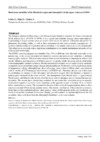Identificador persistente para citar o vincular este elemento:
https://accedacris.ulpgc.es/jspui/handle/10553/114075
| Título: | Short-term variability of the Dissolved oxygen and chlorophyll a in the upper waters at ESTOC | Autores/as: | López, L. Vega Moreno, Daura Cianca, A. |
Clasificación UNESCO: | 2510 Oceanografía 251001 Oceanografía biológica 251002 Oceanografía química |
Fecha de publicación: | 2014 | Conferencia: | IV Congress of Marine Sciences | Resumen: | The European Station for Time Series in the Ocean, Canary Islands is located in the Eastern Subtropical North Atlantic Gyre (29’10ºN, 15’30ºW). It is a logistic and scientific strategy whose main objective is performing a long-term-time series of oceanic observations in order to understand and predict the phenomena happening within, as well as their environmental and socio-economic consequences. In addition with the results the researchers aim to contribute to the marine science and to the ocean health. This effort has to conclude with a significant contribution to the current international networks of the oceanographic knowledge. The ESTOC sampling program was monthly from 1994 to 2004 and after this time seasonally to the present day, so the studies developed are related to seasonal and interannual variability of different oceanographic variables. The time-series analysis from several resolutions is important in order to find out the influence and interactions of different process happening inside the ocean and its relationship with oceanographic variables variations. For this reason in this research we will study the daily variations compared to seasonal and interannual changes already published. To this end, we have used observations of temperature, salinity, chlorophyll and dissolved oxygen from surface to 300 m which were obtained with 15 profiles of CTD during period of 36 hours at ESTOC site. Therefore, the first aim in this study is establishing the changes in the chlorophyll and dissolved oxygen (DO) distributions compared to hydrographic variations in the water column. The homogenous layer (Mixed layer) is typical during Winter period and March is the month when this layer starts to disappear due to seasonal thermocline formation. The second aim is determining variations for net community production using the anomaly of dissolved oxygen (∆O2 excess above saturation, or the apparent oxygen utilization, AOU, as deficit below saturation) as a tracer. The seasonal distribution of the dissolved oxygen anomaly shows a deep maximum (around 150 m) during summer season. Our interest is to find out if the productive processes, in detriment of the respiration process, show positive values of DO anomaly in the daily resolution and where is located the maximum if this exists. Finally, we will establish the relationship between the DO anomalies values with those from the chlorophyll distribution in the water column. | URI: | https://accedacris.ulpgc.es/handle/10553/114075 | ISBN: | 84-697-0471-0 | Fuente: | Book of Abstracts submitted to the IV Congress of Marine Sciences. Las Palmas de Gran Canaria, June 11th to 13th 2014, p. 208 |
| Colección: | Actas de congresos |
Visitas
98
actualizado el 31-oct-2024
Descargas
19
actualizado el 31-oct-2024
Google ScholarTM
Verifica
Altmetric
Comparte
Exporta metadatos
Los elementos en ULPGC accedaCRIS están protegidos por derechos de autor con todos los derechos reservados, a menos que se indique lo contrario.
